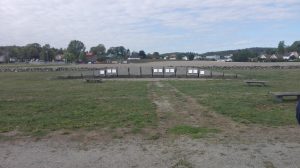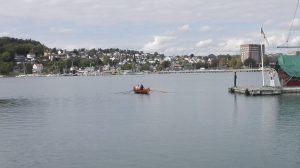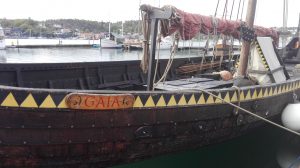The excursion of this week was also about boats, but a specials ones, which were used several years ago, during the viking age (800- 1066 AD). Now they are really famous, and a lot of them have replicas at the museums around Norway.
Last Monday, September 3th, we went on a tour around the southeast of Norway and they show us some of the places where they had found the firsts Viking boats. After that, I could understand why Norway is well-known as the Viking land, because they lived here for several years, but the main point is that they leave a lot of clues and materials that help historians know the way they lived: traditions, sailing methods, costumes…
At the image you could see the size of one of these Viking ships, it was large but not very huge because it used to sail in the sea, but also through the rivers. This type of navy were handmade and they usually use oak for built them. The most interesting things for me was the stones they use for make the boat heavier and float easily. They were used for fighting and for conquest more places due to the boats could sail inside the rivers and go hiding until the strategic places.
In contradiction to this traditional fame in Norway, I want to say that in Valencia, where I came from, we also have a lot of navy industry, however we don’t have ships like this, I’ve always seen boats destinated to the freigh transport, because Valencia has a big comercial port even now.
After the guide tour, we had the change for trying to row a small Viking boat around the port with an expert on this technique. I’ve practiced kayaking and rafting several times before in my hometown, so I have basic ideas of rowing with someone else, which is more difficult than going alone,because you must synchronize your movements. However, this was greatly more difficult, because while you’re rowing you can’t see your destination point, this makes you more insecure where are you going to. Moreover the wood oars were really heavy so you need to be strong enough to move the rowboat. Here you have a picture of the small boat we tried to row at.
Then we had lunch, and after all, with a group of Norwegian student we sailed and rowed a replica of one of the amazing oldest Viking boats, the Gaia. While we were waiting we explore a bit around and we could see that all the boats on this port were old or outmoded, so it seemed an active museum. We don’t have this treasures in the port of Valencia, there we have more modern boats and ferries, but not tradicional boats handmaded by wood, which for me are amazing relics because you could feel better the connection with the sea while you are rowing, it’s all more fluent.
From my point of view, this was the best part of the excursion, because not everyone have the chance of rowing this boat, and learn how to put the paddles ready and keep them after. Furthermore, the teachers explained us how Vikings set sails unfortunately we couldn’t do it because it was so tricky, and the sail was too heavy for us.
After reading this post, I hope you’ll try to sail on a viking boat, if you have the opportunity on your Norwegian trip!
Marina



